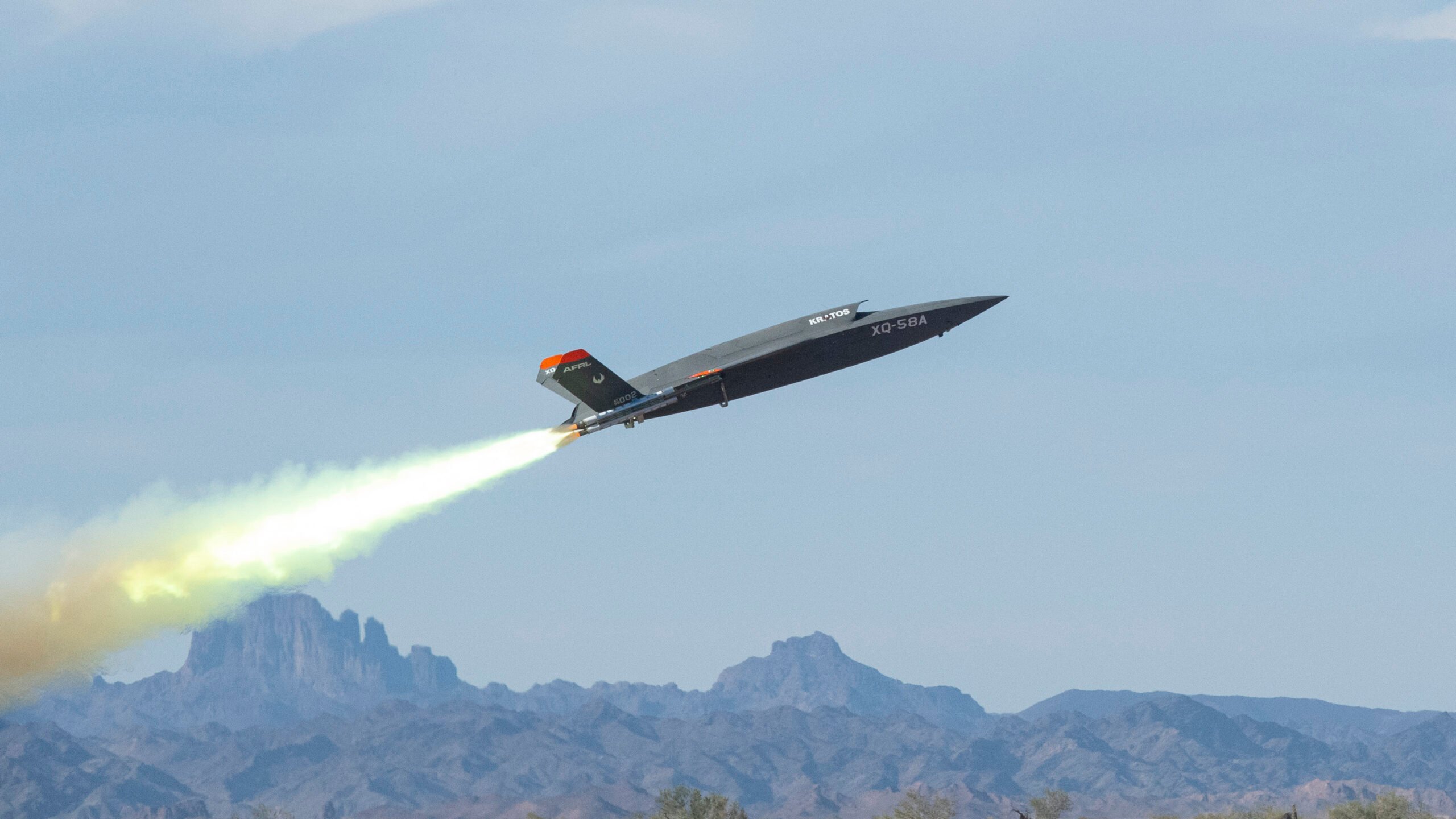
An XQ-58A Valkyrie low-cost unmanned aerial vehicle launches at the U.S. Army Yuma Proving Ground, Ariz., Dec. 9, 2020. (U.S. Air Force photo by Staff Sgt. Joshua King)
AFA WARFARE SYMPOSIUM — When the Air Force selected five prime vendors for the first increment of its ambitious Collaborative Combat Aircraft (CCA) drone wingman program, as first reported by Breaking Defense, it may have been surprising to some for a name that was left off the list: Kratos Defense and Security Solutions.
After all, Kratos is the maker of the XQ-58A Valkyrie, an unmanned jet-powered platform with which the Air Force Research Laboratory had already experimented, and has caught the interest of the US Marines.
Kratos officials have not said if they made a play for a prime spot in the first increment, and since have been coy about whether they’re subcontracting with another prime for any of the work. But now, as the Air Force prepares for the second round of the program, Steve Fendley, president of Kratos’s unmanned systems division, told Breaking Defense the company wants to take prime status of its own.
“Yes, we are,” Fendley said on the sidelines of the Air & Space Forces Association’s Air Warfare Symposium on Wednesday when asked if the company is aiming to be a prime for CCA’s second increment.
This week Air Force Secretary Frank Kendall disclosed the service was moving to winnow down the current pool of five vendors and launch another round of CCA work, known as the program’s second “increment,” in fiscal year 2025.
Echoing remarks from Kratos Chief Executive Officer Eric DeMarco on a recent earnings call, Fendley explained that “across the corporation,” Kratos’s strategy has been to evaluate where it could best be positioned as a prime, or could “form a relationship with a major prime” as a subcontractor. One consideration identified by Fendley for when it might make more sense to pursue a partnership for a program rather than chase it as a prime is Kratos’s size: the company has about 4,000 employees, he said, a workforce that pales in comparison to those of industry giants with headcounts of 100,000 or more.
During that earnings call, DeMarco touted a “very successful” approach to serving as a partner instead of a prime in some cases, including for a “high-profile program” he did not name. Asked by an investor about both CCA and the Pentagon’s separate Replicator initiative, DeMarco declined to respond about any individual program, saying “every drone program that’s out there, we’re expected to be in. I’ll leave it at that.”
Regarding the pool of CCA prime vendors on contract with the Air Force for the first increment, Fendley emphasized there are “five primes” — previously identified as Boeing, General Atomics Aeronautical Systems, Lockheed Martin, Northrop Grumman and startup Anduril. He declined to comment whether Kratos is serving as a subcontractor.
But pointing to Kratos’s role as a prime on other programs such as fielding the Valkyrie, he said the company is well-positioned for future CCA opportunities that are expected to yield a “family of systems” with “multiple aircraft types.”
Asked about what could be different for the company in the second increment expected to kick off in FY25, Fendley said that generally speaking, a company’s capabilities can evolve over time and its relationship with its customers can deepen. “As you get to a program that’s 10 times or 100 times the size of” a program the firm traditionally served as a prime for, he said, “that kind of changes the calculus for a company like Kratos.
“So there’s a sweet spot for where we can prime it and there’s a stretch area,” he continued. “What I hope is you see the sweet spot increases and the stretch area is moving to higher” program sizes and complexities.
As for whether Kratos has the capacity to perform as a prime for second increment, Fendley told Breaking Defense, “It depends on what the system is. I don’t know what increment two will be. The government has not announced that to industry in a public forum… We certainly wouldn’t decide today. We don’t know what it is.”
Regarding the CCA program overall, Fendley said “the Air Force has a very definitive plan that they’re executing against” and that the service has “done a good job collecting all of the advancements” in uncrewed systems.
Yet he also had some feedback for the service, reasoning that industry has had to “do a little bit of head scratching and predicting to navigate.”
“I think the leaders know very clearly what they’re trying to do. I don’t think they’ve shared all the data. That’s really my message,” he said.






















